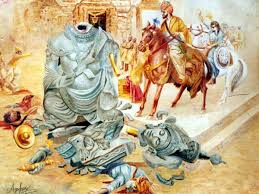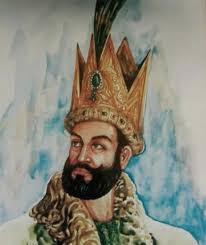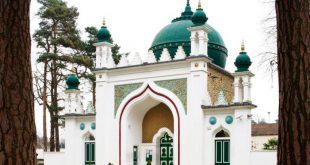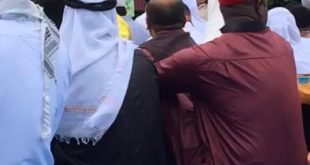 Mahmud of Ghazna , 971?–1030, Afghan emperor and conqueror. He defeated (c. 999) his elder brother to gain control of Khorasan (in Iran) and of Afghanistan. In his raids against the states of N India, Mahmud, a staunch Muslim, destroyed Hindu temples, forced conversions to Islam, and carried off booty and slaves. Hindus especially abhorred his destruction of the temple to Shiva at Somnath in Gujarat. Mahmud’s territorial gains lay mainly W and N of Afghanistan and in the Punjab. At Ghazna (seeGhazni), his capital, he built a magnificent mosque. His successors in the Ghaznavid dynasty, which Mahmud founded, ruled over a reduced domain with the capital at Lahore until 1186
Mahmud of Ghazna , 971?–1030, Afghan emperor and conqueror. He defeated (c. 999) his elder brother to gain control of Khorasan (in Iran) and of Afghanistan. In his raids against the states of N India, Mahmud, a staunch Muslim, destroyed Hindu temples, forced conversions to Islam, and carried off booty and slaves. Hindus especially abhorred his destruction of the temple to Shiva at Somnath in Gujarat. Mahmud’s territorial gains lay mainly W and N of Afghanistan and in the Punjab. At Ghazna (seeGhazni), his capital, he built a magnificent mosque. His successors in the Ghaznavid dynasty, which Mahmud founded, ruled over a reduced domain with the capital at Lahore until 1186
Sultan Mahmood Ghaznawi at the age of 27 announced his claim to the throne of Afghanistan and his brother Ismael announced his claim to be king from the city of Balkh. Mahmood defeated his brother in Ghazni captured him and imprisoned him for life in the province of Jowzjan. Meanwhile he defeated the Samani kingdom and captured Toos. Mahmood intended to make this kingdom more powerful and sought to bring wealth to his capital in Ghazni. His influences reached Baghdad and captured Gorjistan from Abu Naser, Sistan from Khalf Bin Ahmad and by 1002 ad Sultan Mahmood Ghaznawi defeated the mighty Khalif Bin Ahmad and Amir Omar and stopped his western conquers and concentrated towards the eastern fronts
In 1001 Sultan Mahmood defeated Jeebal the king of Kabulistan and marched further into Peshawer and in 1005 makde it his center for his forces. From this strategic location Mahmood was able to capture Panjab in 1007, Tanseer fell in 1014, Kashmir was captured in 1015 and Qanoch fell in 1017. By 1027 Sultan Mahmood had captured most of northern India. Sultan Mahmood would place his prisoners of war in jail and never hanged him for any reason, he would let them die in prison instead.
On 1010 Sultan Mahmood Ghaznawi captured Ghor and by 1011 annexed Balouchistan. Sultan mahmood had already had relationships with the leadership in Blakh through marriage, Abu Nasr Mohammad offered his services to Sultan Mahmood and offered his daughter to Mohammad son of Sultan Mahmood. After Nasr’s death Mahmood brought Balkh under his leadership.
 By 1017 Aliak Khan, an ally of Sultan Mahmood invaded Heart and Balkh. This was out of the ordinary because Sultan Mahmood had married Aliak Khan’s daughter 18 years earlier. Sultan Mahmood gathered a powerful force of 50 thousand warriors and attacked the heart of Aliak Khans army. Sultan Mahmood was in full armor in this battle and has personally captured Aliak Khan’s flag and forced him across the Jayhoon river ( Amu Darya).
By 1017 Aliak Khan, an ally of Sultan Mahmood invaded Heart and Balkh. This was out of the ordinary because Sultan Mahmood had married Aliak Khan’s daughter 18 years earlier. Sultan Mahmood gathered a powerful force of 50 thousand warriors and attacked the heart of Aliak Khans army. Sultan Mahmood was in full armor in this battle and has personally captured Aliak Khan’s flag and forced him across the Jayhoon river ( Amu Darya).
 By 1024 Sultan Mahmood was so powerful that he crossed the Amu River and fearing his advance Qadr Khan the brother of Aliak Khan greeted Sultan Mahmood and offered him his full cooperation. Qadr Khan and offered his son to Sultan Mahmood for services.In 1030 Sultan Mahmood Fell gravely ill and died at the age of 59. Sultan Mahmood was a very strong man gifted speaker and was very handsome. He was a great warrior and showed great horsemanship skills. Though he didn’t understand the Arabic language but was well versed in the laws of Islam. He loved poetry, Astronomy and Math and would encourage others to learn. Sultan Mahmood had no tolerance for other religions and only praised Islam due to its pureness and un-edited texts. Universities were formed were subjects of Math, Religious Studies, Humanities and Medicine were thought only within the laws Sahria. Islam was the Main religion of his Kingdom and Dari language replaced the many different languages spoken at the time. For the first time ever, this region was under one rule, one religion and one language.
By 1024 Sultan Mahmood was so powerful that he crossed the Amu River and fearing his advance Qadr Khan the brother of Aliak Khan greeted Sultan Mahmood and offered him his full cooperation. Qadr Khan and offered his son to Sultan Mahmood for services.In 1030 Sultan Mahmood Fell gravely ill and died at the age of 59. Sultan Mahmood was a very strong man gifted speaker and was very handsome. He was a great warrior and showed great horsemanship skills. Though he didn’t understand the Arabic language but was well versed in the laws of Islam. He loved poetry, Astronomy and Math and would encourage others to learn. Sultan Mahmood had no tolerance for other religions and only praised Islam due to its pureness and un-edited texts. Universities were formed were subjects of Math, Religious Studies, Humanities and Medicine were thought only within the laws Sahria. Islam was the Main religion of his Kingdom and Dari language replaced the many different languages spoken at the time. For the first time ever, this region was under one rule, one religion and one language.
 Komashisha
Komashisha




